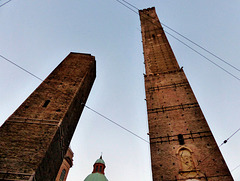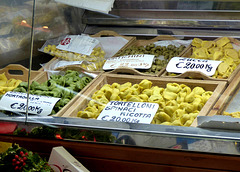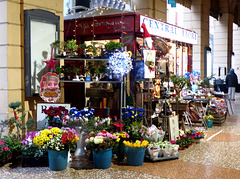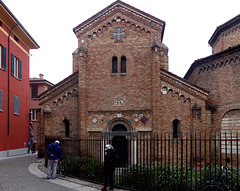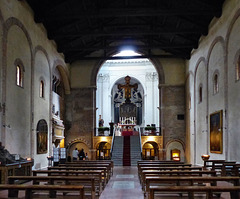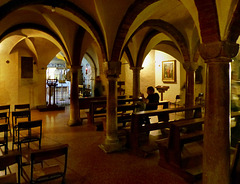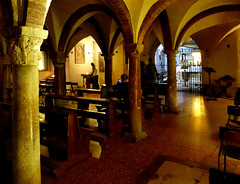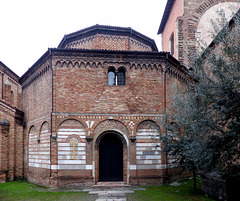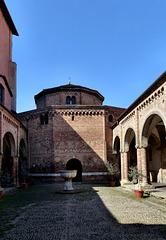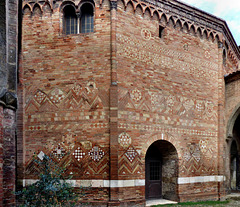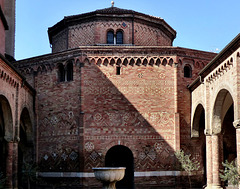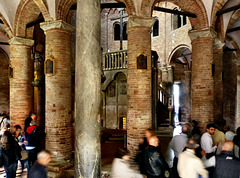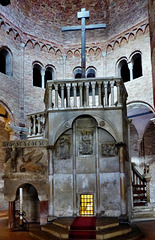
Bologna
Photos taken during various visits over the years.
Bologna - Le due torri
| |
|
These two towers are a landmark of Bologna.
It is estimated, that within the 12th century the number of towers in Bologna was up to 180. In medieval times the city must have had a skyline like Manhattan today. From the end of the 13th century on many towers were taken down, others collapsed. Even in the early 20th century two towers got demolished. About twenty medieval towers still exist, but all of them are dismanteled to the hight of the surrounding buildings.
All but these two, both erected between 1109 and 1119. !
The Asinelli Tower
initially had a height of 70m and was raised later to the current 97.2 m. When in the 14th century the tower was used as a prison and small stronghold, an aerial footbridge was added at a height of 30 m above ground connecting to the neighbouring Garisenda Tower. This bridge was destroyed during a fire in 1398. Lightning often caused damage. Since 1824 a lightning rod is installed here.
The Garisenda Tower
once had a height of 60m, but due to a yielding of the ground a significant incline started. The tower was becoming more and more dangerous and between 1351 and 1360 it was cut off. So the tower today has a height of 48m with an overhang of 3,2 m. In the early 15th century, the tower was bought by the "Arte dei Drappieri" ("Guild of of Drapers"). The guild owned it upto the 19th century.
Bologna - Bottega Della Luce
| |
|
|
A night stroll through the city of Bologna, capital of the Emilia-Romagna. Not only Osram light bulbs, as well as a wide range of electrical appliances are offered here - in daytime.
Bologna - Night Rock
| |
|
Strolling through Bologna at late evening. A rock band performs in front of a coffee shop on the Via Ugo Bassi. Seen in the background is the Asinelli Tower.
Bologna
| |
|
|
|
Bologna is the capital of the Emilia-Romagna region. Founded by the Etruscans, the city has been an urban center for centuries, first under the Etruscans, then under the Celts, then under the Romans, and again in the Middle Ages, when it was among the largest European cities by population. It is home to the oldest university in Europe established in 1088.
Bologna is renowned for its culinary tradition. It is the home of the famous Bolognese sauce, called ragù.
As in all of Emilia-Romagna, the production of cured pork meats such as prosciutto and salumi is an important part of the local food industry. Mortadella counts to the Bolognese specialities.
So shopping for the Christmas dinner is very extensive here.
Bologna - Central Fiori
| |
|
Bologna is the capital of the Emilia-Romagna region. Founded by the Etruscans, the city has been an urban center for centuries, first under the Etruscans, then under the Celts, then under the Romans, and again in the Middle Ages, when it was among the largest European cities by population. It is home to the oldest university in Europe established in 1088.
Bologna is renowned for its culinary tradition. It is the home of the famous Bolognese sauce, called ragù.
As in all of Emilia-Romagna, the production of cured pork meats such as prosciutto and salumi is an important part of the local food industry. Mortadella counts to the Bolognese specialities.
Bologna is famous for its elegant and extensive porticoes. In total, there are some 38 kilometers of porticoes in the city's historical center.
Central Fiori
Bologna - Sette Chiese
| |
|
"Sette Chiese" (= "Seven Churches") or "Santa Gerusalemme" (= "Holy Jerusalem") encompasses a complex of interconnected religious edifices, erected between the 5th and the 13th century.
According to tradition Saint Petronius, a bishop during the 5th century, built the first basilica. He actually wished a building that recalled the Church of the Holy Sepulchre in Jerusalem.
"Sette Chiese" is a very complex structure, so this model gives an overview.
Bologna - Basilica dei SS. Vitale e Agricola
| |
|
|
Bologna is the capital of the Emilia-Romagna region. Founded by the Etruscans, the city has been an urban center for centuries, first under the Etruscans, then under the Celts, then under the Romans, and again in the Middle Ages.
In 728 Bologna was conquered by the Longobard king Liutprand and thus became part of the Longobard Empire.
In the 11th century, the place grew again as a free commune. In 1088 the university was founded, today the oldest university in Europe. As the city continued to expand, it received a new ring of ramparts in the 12th century, and another was completed in the 14th century.
In 1164 Bologna joined the Lombard League against Frederick I Barbarossa, and in 1256 the city promulgated the "Legge del Paradiso", which abolished serfdom and slavery and freed the remaining slaves with public money. The city center was a forest of towers. It is estimated that around 100 family towers of the leading families, church towers, and towers of public buildings defined the cityscape.
In 1272, King Enzio of Sardinia, an illegitimate son of the Hohenstaufen Emperor Frederick II, died in Bologna after more than 22 years of imprisonment.
The "Church of the Saints Vitale and Agricola" is just like the Basilica di Santo Stefano part of "Sette Chiese" (= "Seven Churches") or "Santa Gerusalemme" (= "Holy Jerusalem"). It comprises a complex of interconnected religious buildings built between the 5th and 13th centuries.
According to tradition, St. Petronius, a bishop in the 5th century, built the first basilica. He wanted a building reminiscent of the Church of the Holy Sepulchre in Jerusalem.
-
Bologna - Basilica di Santo Stefano
| |
|
|
The "Basilica di Santo Stefano" is as well known as "Sette Chiese" (= "Seven Churches") that encompasses a complex of interconnected religious edifices, erected between the 5th and the 13th century. - See previous upload for an overview.
According to tradition Saint Petronius, a bishop during the 5th century, built the first basilica. He actually wished a building that recalled the Church of the Holy Sepulchre in Jerusalem.
Seen here is the facade of the Chiesa del Crocifisso. To the left is the Basilica del Sepolcro ("Basilica of the Holy Sepulchre"), a rotunda, further left (behind the white truck) the facade of the Basilica dei SS. Vitale e Agricola.
Bologna - Chiesa del Crocifisso
| |
|
|
The Chiesa del Crocifisso (= "Church of the Cross") is part of the "Basilica di Santo Stefano" known as "Sette Chiese" (= "Seven Churches") that encompasses a complex of interconnected religious edifices, erected between the 5th and the 13th century.
The Chiesa del Crocifisso is dated to the 8th/9th century, though it got altered later in many ways. Seen here is the nave. Under the risen choir is a large crypt.
Bologna - Chiesa del Crocifisso
| |
|
The Chiesa del Crocifisso (= "Church of the Cross") is part of the "Basilica di Santo Stefano" known as "Sette Chiese" (= "Seven Churches") that encompasses a complex of interconnected religious edifices, erected between the 5th and the 13th century.
The Chiesa del Crocifisso is dated to the 8th/9th century, though it got altered later in many ways. Seen here is the Baroque choir.
Bologna - Chiesa del Crocifisso
| |
|
The Chiesa del Crocifisso (= "Church of the Cross") is part of the "Basilica di Santo Stefano" known as "Sette Chiese" (= "Seven Churches") that encompasses a complex of interconnected religious edifices, erected between the 5th and the 13th century.
The Chiesa del Crocifisso is dated to the 8th/9th century, though it got altered later in many ways. The Romanesque crypt, below the risen choir, has a nave and two aisles on either side.
Bologna - Chiesa del Crocifisso
| |
|
|
|
The Chiesa del Crocifisso (= "Church of the Cross") is part of the "Basilica di Santo Stefano" known as "Sette Chiese" (= "Seven Churches") that encompasses a complex of interconnected religious edifices, erected between the 5th and the 13th century.
The Chiesa del Crocifisso is dated to the 8th/9th century, though it got altered later in many ways. The Romanesque crypt, below the risen choir, has a nave and two aisles on either side.
Bologna - Basilica del Sepolcro
| |
|
|
Bologna is the capital of the Emilia-Romagna region. Founded by the Etruscans, the city has been an urban center for centuries, first under the Etruscans, then under the Celts, then under the Romans, and again in the Middle Ages.
In 728 Bologna was conquered by the Longobard king Liutprand and thus became part of the Longobard Empire.
In the 11th century the place grew again as a free commune. In 1088 the university was founded, today the oldest university in Europe. As the city continued to expand, it received a new ring of ramparts in the 12th century, and another was completed in the 14th century.
In 1164 Bologna joined the Lombard League against Frederick I Barbarossa, and in 1256 the city promulgated the "Legge del Paradiso", which abolished serfdom and slavery and freed the remaining slaves with public money. The city center was a forest of towers. It is estimated that around 100 family towers of the leading families, church towers and towers of public buildings defined the cityscape.
In 1272, King Enzio of Sardinia, an illegitimate son of the Hohenstaufen Emperor Frederick II, died in Bologna after more than 22 years of imprisonment.
The Basilica del Sepolcro is just as the Basilica di Santo Stefano part of "Sette Chiese" (= "Seven Churches") or "Santa Gerusalemme" (= "Holy Jerusalem"). It comprises a complex of interconnected religious buildings built between the 5th and 13th centuries.
According to tradition, St. Petronius, a bishop in the 5th century, built the first basilica. He wanted a building reminiscent of the Church of the Holy Sepulchre in Jerusalem. The Church of the Holy Sepulcher in Jerusalem was consecrated in 335.
Petronius´ church got severely damaged during the devastating invasions of Hungarian troops in the tenth century. The octagonal church got rebuilt a century later by Benedictine monks from red bricks.
Bologna - Basilica del Sepolcro
| |
|
|
The Basilica del Sepolcro is part of the "Basilica di Santo Stefano" known as "Sette Chiese" (= "Seven Churches") that encompasses a complex of interconnected religious edifices, erected between the 5th and the 13th century.
Already within the 5th century Bishop Petronius built a "Holy Sepulchre" here, recalling the Church of the Holy Sepulche in Jerusalem, consecrated in 335.
Petronius´ church got severely damaged during the devastating invasions of Hungarian troops in the tenth century. The octogonal church got rebuilt a century later by Benedictian monks. Here is is seen from the cloister named "Cortile di Pilato" ("Pilate's courtyard").
Bologna - Basilica del Sepolcro
| |
|
|
The Basilica del Sepolcro is part of the "Basilica di Santo Stefano" known as "Sette Chiese" (= "Seven Churches") that encompasses a complex of interconnected religious edifices, erected between the 5th and the 13th century.
Already within the 5th century Bishop Petronius built a "Holy Sepulchre" here, recalling the Church of the Holy Sepulche in Jerusalem, consecrated in 335.
Petronius´ church got severely damaged during the devastating invasions of Hungarian troops in the tenth century. The octogonal church got rebuilt a century later by Benedictian monks from red bricks. The outer walls are adorned with Cosmatesque mosaics.
Bologna - Basilica del Sepolcro
| |
|
The Basilica del Sepolcro is part of the "Basilica di Santo Stefano" known as "Sette Chiese" (= "Seven Churches") that encompasses a complex of interconnected religious edifices, erected between the 5th and the 13th century.
Already within the 5th century Bishop Petronius built a "Holy Sepulchre" here, recalling the Church of the Holy Sepulche in Jerusalem, consecrated in 335.
Petronius´ church got severely damaged during the devastating invasions of Hungarian troops in the tenth century. The octogonal church got rebuilt a century later by Benedictian monks from red bricks. The outer walls are adorned with Cosmatesque mosaics.
Bologna - Basilica del Sepolcro
| |
|
The Basilica del Sepolcro is part of the "Basilica di Santo Stefano" known as "Sette Chiese" (= "Seven Churches") that encompasses a complex of interconnected religious edifices, erected between the 5th and the 13th century.
Already within the 5th century Bishop Petronius built a "Holy Sepulchre" here, recalling the Church of the Holy Sepulche in Jerusalem, consecrated in 335.
Petronius´ church got severely damaged during the devastating invasions of Hungarian troops in the tenth century. The octogonal church got rebuilt a century later by Benedictian monks from red bricks. The dome above is dodecagonal. It is supported by 12 columns. Some of them are probably spolia that got reused here.
Bologna - Basilica del Sepolcro
| |
|
The Basilica del Sepolcro is part of the "Basilica di Santo Stefano" known as "Sette Chiese" (= "Seven Churches") that encompasses a complex of interconnected religious edifices, erected between the 5th and the 13th century.
Already within the 5th century Bishop Petronius built a "Holy Sepulchre" here, recalling the Church of the Holy Sepulche in Jerusalem, consecrated in 335.
Petronius´ church got severely damaged during the devastating invasions of Hungarian troops in the tenth century. The octogonal church got rebuilt a century later by Benedictian monks from red bricks. The dome above is dodecagonal. It is supported by 12 columns.
In the center of the "Basilica del Sepolcro" is this structure, that reminds of the Calvary. A mountain with a cross on top over a cave. The pulpit (right) bears the Evangelists´ symbols. In 1141 the relics of Saint Petronius (aka "Bishop Petronus") were rediscovered here - since then they are in the cave of this Calvary.
Jump to top
RSS feed- Latest items - Subscribe to the latest items added to this album
- ipernity © 2007-2024
- Help & Contact
|
Club news
|
About ipernity
|
History |
ipernity Club & Prices |
Guide of good conduct
Donate | Group guidelines | Privacy policy | Terms of use | Statutes | In memoria -
Facebook
Twitter

